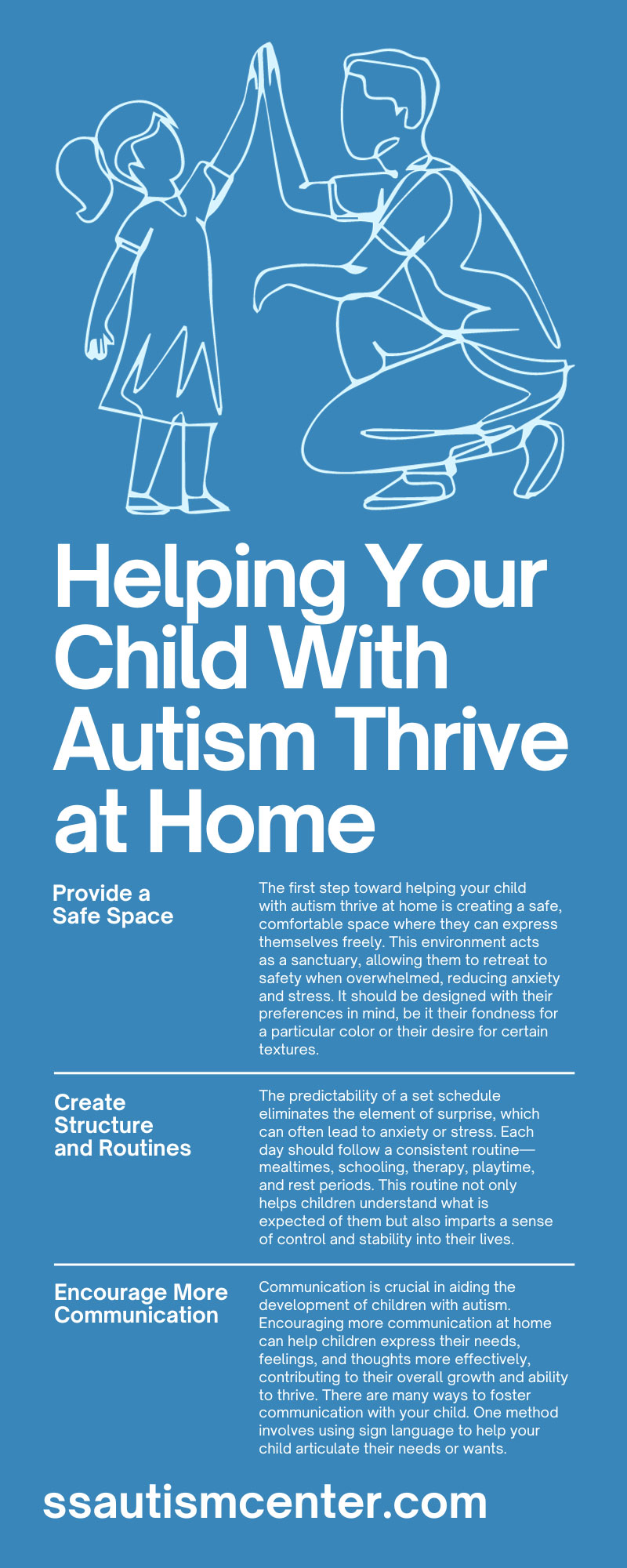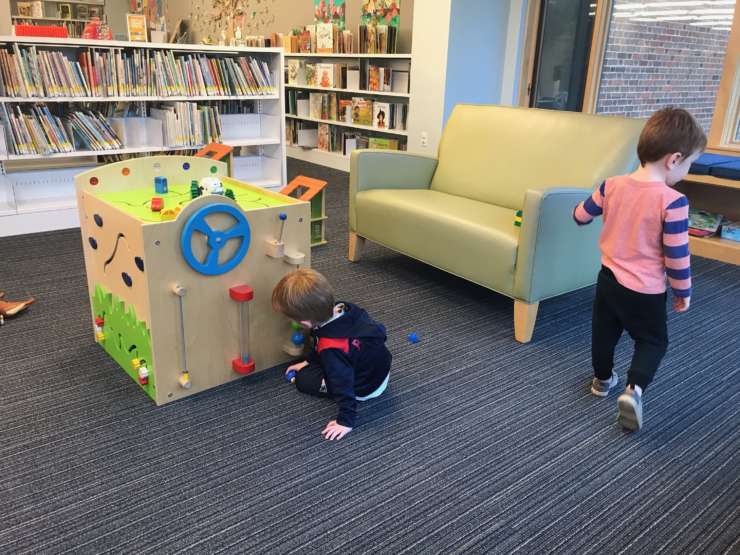Raising a child with autism can present a unique set of challenges—one of which is creating an environment at home where your child can thrive. We will provide practical, easy-to-implement guidance for helping your child with autism thrive at home. We will explore strategies and techniques that not only cater to the specific needs of children with autism but also foster their skills, independence, and joy.
Provide a Safe Space
The first step toward helping your child with autism thrive at home is creating a safe, comfortable space where they can express themselves freely. This environment acts as a sanctuary, allowing them to retreat to safety when overwhelmed, reducing anxiety and stress. It should be designed with their preferences in mind, be it their fondness for a particular color or their desire for certain textures. This personalized space can significantly contribute to their sense of security, self-confidence, and overall emotional well-being. A familiar and predictable environment is key to helping children with autism feel safe and in control.
Create Structure and Routines
Establishing a structured routine can greatly assist children with autism in coping with their daily activities. The predictability of a set schedule eliminates the element of surprise, which can often lead to anxiety or stress. Each day should follow a consistent routine—mealtimes, schooling, therapy, playtime, and rest periods. This routine not only helps children understand what is expected of them but also imparts a sense of control and stability into their lives. Visual aids, such as charts or timelines, can be instrumental in helping them understand and follow these routines. Over time, these established routines can become comforting rituals, giving the child a framework that supports their development and enhances their ability to function effectively at home.
Encourage More Communication
Communication is crucial in aiding the development of children with autism. Encouraging more communication at home can help children express their needs, feelings, and thoughts more effectively, contributing to their overall growth and ability to thrive. There are many ways to foster communication with your child. One method involves using sign language to help your child articulate their needs or wants. Additionally, try to engage in activities that your child enjoys and are social in nature. During these activities, consistently model and reinforce language use. For example, if your child is playing with a toy car, you might say, “The car is going fast,” or ask, “Can you make the car go slow?” This approach can prompt your child to repeat the phrases, facilitating more interaction. Remember that each child is unique, and it’s important to be patient and supportive and celebrate every small victory of expression.
Foster a Sense of Independence
One major objective in empowering your child with autism to thrive is fostering a sense of independence. This pivotal aspect aids in building self-confidence and helps them become more self-sufficient, both within the confines of the home and outside of it. Encourage your child to participate in daily tasks and activities, such as getting dressed, tidying their room, or preparing a simple meal. This engagement with everyday tasks provides opportunities to learn new skills and can imbue a sense of accomplishment. Additionally, it enables them to understand their capabilities, handle challenges, and eventually manage tasks independently. Reinforce their efforts with praise and positive reinforcement to boost their confidence in their abilities. It’s essential to remember that while acquiring these skills may take time, each small step toward independence significantly contributes to their overall development and ability to thrive.
Incorporate Sensory Play
Incorporating sensory play in everyday life is another effective strategy for helping your child with autism thrive at home. Sensory play involves activities that stimulate your child’s senses—touch, smell, taste, movement, sight, and hearing. This type of play can be a powerful tool for them to explore their world, build neural connections, and develop physical, cognitive, and linguistic skills. Moreover, sensory play can aid in reducing anxiety and improving focus, an area often challenging for children with autism. When choosing sensory activities, consider your child’s unique needs and preferences. For example, if your child is captivated by lights, you can create a sensory room with various light-up toys. Alternatively, if your child enjoys tactile experiences, consider activities involving play dough or kinetic sand. Always remember to supervise these activities to ensure safety and provide support as needed. By catering to your child’s preferences, sensory play becomes an enjoyable learning experience that significantly contributes to their ability to thrive at home.
Make Use of Visual Aids
Visual aids can enhance the learning experience and daily functioning of children with autism at home. They can help children understand, process, and retain information more effectively and aid in communication and the development of important life skills. For instance, picture schedules can visually represent a daily routine, helping children grasp the sequence of activities and know what to expect, effectively reducing anxiety. Visual charts can break down more complex tasks into manageable steps, facilitating skill acquisition and promoting independence. Flashcards can be used for vocabulary development and concept understanding and support communication for non-verbal children. These tools can be personalized to suit your child’s needs and interests, making learning more engaging and effective. Remember that visual aids do not have to be complex or elaborate; even simple hand-drawn images can serve the purpose. The aim is to provide clear, understandable visual cues that can assist your child in navigating their day-to-day life, enhancing their skills and independence and ultimately helping them thrive at home.
Celebrate Small Victories
Acknowledging and celebrating small victories is a potent strategy to boost your child’s confidence and reinforce positive behavior. Like all children, children with autism thrive on praise and recognition. As parents, your validation of their accomplishments, however minor, can have a profoundly positive effect on their self-esteem and motivation to learn. Small victories could range from trying a new food, completing a task independently, using a new word, or exhibiting a new social skill. Each of these milestones is significant in their journey and deserves celebration. You can celebrate these victories in various ways, from verbal praises, happy dances, and high fives to small rewards they’ll value. It’s not the size of the achievement that matters but the effort they put into it. By celebrating these small victories, you’re not just reinforcing the behavior or skill learned—you’re helping them to see that they are capable and competent, giving them the confidence to take on new challenges and continue their path of learning and thriving at home.
Now that you know a few effective ways to help your child with autism thrive at home, you can start incorporating these strategies into your daily routines with your child. Remember that every child is unique, and you can tailor these strategies to best suit your child’s individual needs, preferences, and pace. If you’re looking for early autism services, contact South Shore Autism Center today. Remember, you are not alone in this. There is a community of parents and caregivers navigating the same path, and we’re here to support each other.





Comments (0)